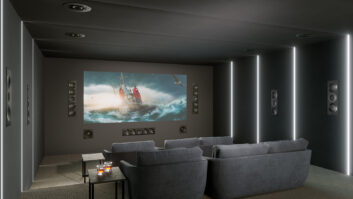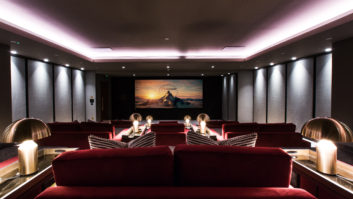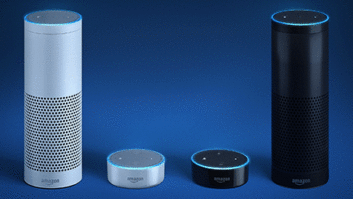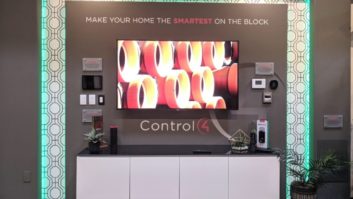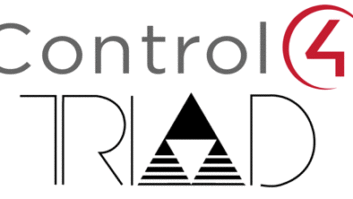In the CEDIA channel’s 20-year history, two technologies have served as the foundation upon which much of the residential AV integration industry has been built. In-wall speakers are often considered the cornerstone of this proverbial structure, while the frame, it could be argued, is distributed audio technology.

Linear’s DIGI-5-based Encore system distributes audio in a 24-bit digital format.
The distributed audio category has changed a lot in recent years as manufacturers have moved away from long, and expensive speaker wire runs and heavy-duty amps to more efficient digital products that send their signals over a Cat-5 or even robust Powerline Carrier backbone to amplified keypads or other specialized user interfaces.
Here’s a look at just some of what today’s key players are offering a dealer whose client just wants beautiful music in multiple rooms of their house without too much hassle.
NO NEW WIRES
No two companies have made a bigger combined splash in the category over the past 12 months than NuVo and Russound, as both introduced Powerline Carrier-based distributed audio solutions to the channel. At their core, NuVo’s Renovia line and Russound’s Collage system are not all that different. But the devil, both companies would argue, is in the details.
In NuVo’s design, an installation begins when a Renovia Source Hub is plugged into an AC outlet. From there, using Home Plug PLC technology, audio and metadata is transmitted to each zone of a home over its electrical wiring. In each zone, the Renovia audio and metadata is received and adapted by a NuVo Zone Amplifier (NV-RVZA50S), which fits in a split-design dual-gang wall box and consists of two components: a power supply and an amplifier. An electrician is required to complete the AC connection on the power supply.
The Zone Amplifier connects to architectural or freestanding speakers in the room using speaker wire, providing 50 watts of output. To help the integrator know what to expect of a home’s electrical infrastructure before closing the sale and before installing a Renovia system, NuVo offers dealers its two-piece Renovia Site Analysis Tool (NV-RVSAT), as well.
On the other hand, Russound’s PLC multiroom audio distribution product requires no hub or central controller. The approach makes its system’s expansion linear and allows zones and sources to be placed anywhere in the home. This decentralized design, Russound designers say, enables Collage to be a low-cost investment for consumers who want to begin with two or three zones before expanding to additional areas at a later date.
Collage is designed to fully maximize the IP backbone created by the system, giving the user access to all of their content on their network, as well as Internet services such as Rhapsody. As it is a distributed system, there is no cost penalty for installing as few as one or two zones, or as many as 10.
SOME NIRV
No new wires is nice, but many multi-room audio products still depend on a backbone based on Cat-5 cabling.

At their core, NuVo’s Renovia line and Russound’s Collage system are not all that different. But the devil, both would argue, is in the details.
SpeakerCraft made a big splash at CEDIA EXPO with what is much more than just an audio distribution product. Called Nirv, Jeremy Burkhardt’s new baby is actually a media distribution product featuring what the company is promoting as a greatly simplified control system with “uncomplicated programming” and ease of use. That being said, SpeakerCraft’s director of engineering Jason Craze pointed out that Nirv also was built to be “the de-facto audio distribution system.”
He explained that Nirv “uses proven technology” (Cat-5) to move uncompressed CD quality audio from up to 256 sources around the network to up to 256 zones with zero latency. Sources can include “legacy” analog/digital players plugged into input devices, metadata sources such as iPod or media servers, and Internet media streaming sources via Nirv’s own Media Manager input card. The system also integrates page/doorbell/intercom in the same products.
“The true power is in the design,” Craze noted. “Virtually limitless in the number of zones and sources, Nirv can handle any environment all through one main controller. The inputs and outputs are completely modular, so you only add what you need when you need it. You can add zone amps in eight-channel or two-channel steps, allowing for any zone number to be reached without worrying about the next big controller you have to buy. Any source can be routed to any zone, no matter where it sits in the house—all the inputs are system inputs.”
NEW FROM DIGI-5
Also within the Nortek family, a Cat- 5-based platform called DIGI-5, which was introduced with much fanfare two years ago, is still alive and well.
Xantech was the first sister company to introduce a DIGI-5 solution, but the most recent addition comes from Linear Corp., with its Encore Digital Audio Distribution System. According to Linear product line manager, Steve Citron, Encore distributes audio in a 24-bit digital format (a higher resolution and sampling rate than CD sound quality), and the system’s digital architecture also has a high level of immunity to interference and noise, resolving the distortion problems common to analog-based audio systems.

According to Citron, each keypad incorporates a digital amplifier that provides up to 80 watts RMS output for each zone, at less than one percent total harmonic distortion. “Unlike similarly priced systems that deliver music at lower background volume levels, the integrated Encore keypad amplifiers deliver more than enough power to move whole-house audio to the foreground—providing a powerful and dynamic sound that is bold, clean, and detailed,” he said.
Each keypad also provides the ability to adjust bass, treble, balance, and several other features, allowing users to customize the sound for the acoustics in each room, as well as control of system- wide functions such as whole-house music mode.
For electronic systems contractors, the Encore System’s digital architecture makes it possible to distribute audio over a single Cat-5 cable at runs well over 500 feet with no signal loss.
SWITCHING GEARS… OR AUDIO
Acting as an extension to RTI’s control systems, the AD-4 fourzone distributed audio matrix switcher offers a low-cost solution for distributing music in a residential or commercial installation.

Crestron’s Adagio is designed for homes with no more than 24 zones of audio and one home theater.
Containing both a matrix switching pre-amp and a built-in power amplifier, the AD-4 offers the flexibility to augment four local source inputs with four remote source inputs, such as a bedroom CD player, iPod docking station, or an office PC. For a simple, clean installation, a single Cat-5 cable connects the remote source’s audio and infrared signals to the AD-4. To meet the needs of larger projects, the matrix switcher can be expanded to eight zones by cascading two units together.
ADDING TO INTELLICONTROL
For several years, Niles Audio’s multi- zone audio flagship has been its card-based IntelliControl system. Expandability always has been the name of the game for the IntelliControl line, and expand is just what Niles did when it recently added the IM-iCARD2 iPod Integration Module and two new iWARE products for use with the ZR-6 MultiZone Receiver and TS-Pro Color Touchscreen. All three of these products are compatible with the latest iPod devices, supporting Apples’ new iPod charging circuitry.
The SmartDock2 is an iPod docking/charging station that switches iPod connections between iTunes operating on a PC, and Niles MultiZone systems. The ES2 Wall Mount Extender System enables the user to locate the iPod that’s connected to the system virtually anywhere in the home, while preserving the signal quality and the iPod menu system. According to the company, it also utilizes balanced/differential audio to maintain audio quality and to reject noise and hum pickup.

Niles has expanded its IntelliControl line with an IM-iCARD2 iPod Integration Module and two new iWARE products for use with the ZR-6 MultiZone Receiver and TS-Pro Color Touchscreen.
CRESTRON’S LOWER-COST ANSWER
DigitalMedia earned Crestron a lot of ink at CEDIA EXPO, but the company’s Adagio line remains as a solid, low-cost, fully integrated distributed audio system for the Rockleigh, New Jersey-based control giant.
Adagio combines several different components into a single platform, including amplifier, multizone switcher, tuners, and control. According to marketing director Jeff Singer, the system provides plug-and-play connectivity with Crestron keypads and remotes, iServer audio server, IDOCV interfaces for iPod, thermostats, lighting, and shade control.
“The native graphics engine displays a Crestron touchpanel GUI on the TV screen for easy navigation and complete home control,” Singer explained. “AMS-AIP combines professionalgrade HD digital home theater with 7.1 surround sound and multi-zone distributed audio in one package. It’s the easiest system to install. There’s no system design. There’s just one box. No extra wiring and connectivity. No programming. Just plug it in, use the setup wizard for any necessary configuration, and it’s ready in minutes.”
Singer added that Adagio is a good option for homes with no more than 24 zones of audio and one home theater. The built-in Crestron control system also enables connectivity for up to 24 room controllers (or combination of 12 APADs and 12 12-button keypads), four wireless remotes (up to two gateways), four zones of HVAC (thermostats), 30 wireless dimmers (up to two gateways), eight shade groups, one iServer, two IDOCV.

